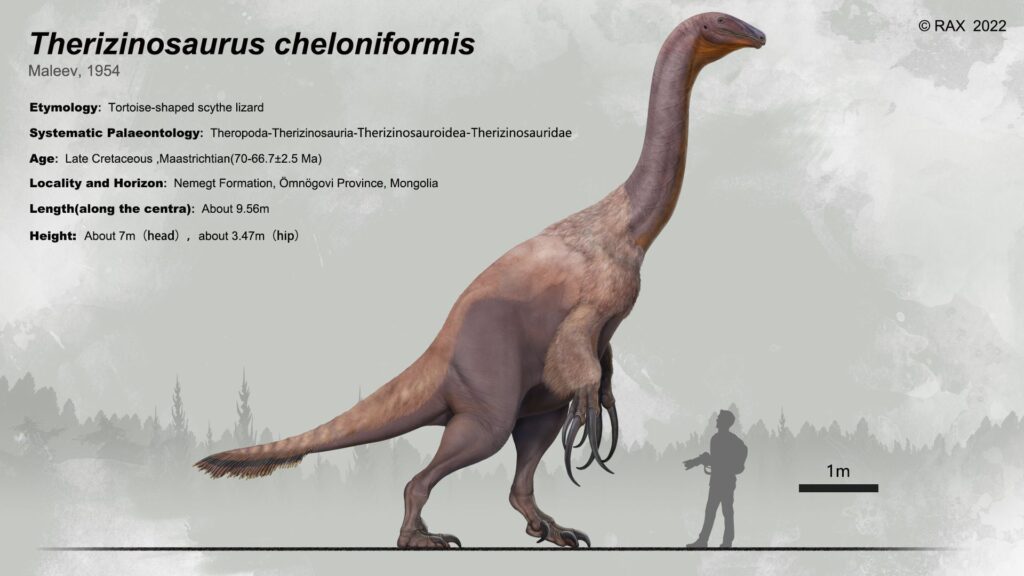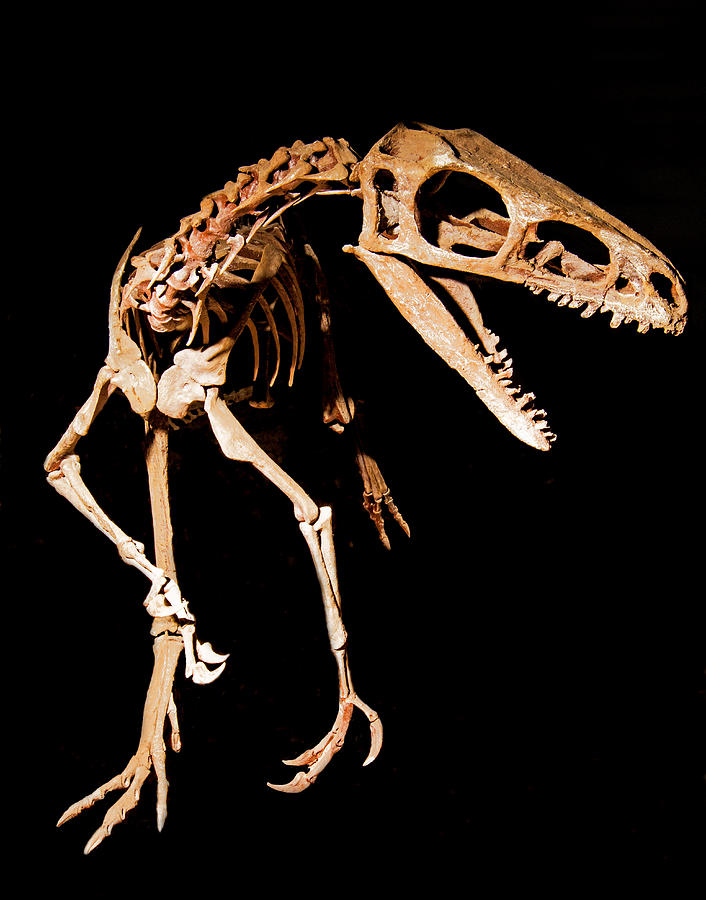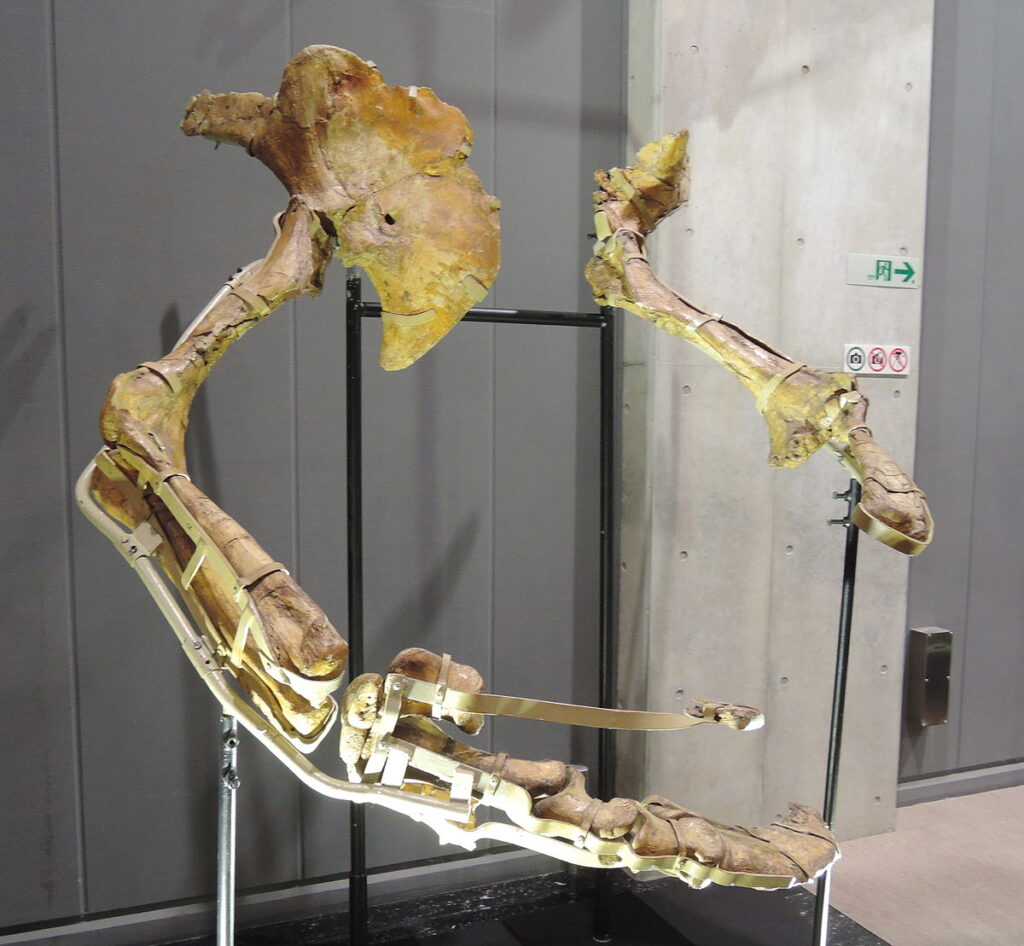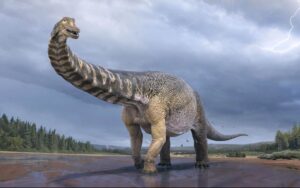Therizinosaurus: The Scythe-Lizard of Prehistory
Introduction
Imagine a dinosaur with towering claws longer than a samurai sword, a pot-bellied torso more suited to a herbivore than a predator, a long neck like a giraffe, and feathers covering its bulky frame. This is Therizinosaurus, one of the most bizarre and misunderstood dinosaurs ever discovered. Its appearance alone challenges everything we typically associate with theropods—a group that includes fierce meat-eaters like Tyrannosaurus rex and Velociraptor.
Originally discovered in the mid-20th century, Therizinosaurus has gone from a puzzling enigma to a central piece of the evolutionary puzzle showing how some of the most ferocious dinosaurs gave rise to entirely different forms—including gentle, feathered plant-eaters. This article takes a deep dive into the fascinating story, anatomy, behavior, and scientific significance of this prehistoric oddity.
The Name and the First Mystery
The name Therizinosaurus means “scythe lizard,” derived from its most striking feature—gigantic claws measuring over three feet long. These claws were so alien in structure that when scientists first uncovered them in the 1940s in Mongolia, they thought they belonged to a massive prehistoric turtle. Only later did more complete fossil discoveries reveal that these claws were part of a bipedal dinosaur with a suite of unique and unexpected traits.
The species name Therizinosaurus cheloniformis actually reflects this early misidentification. “Cheloniformis” translates roughly to “turtle-shaped,” a nod to the first interpretation of the creature’s identity.

Size and Physical Description
Therizinosaurus was a true giant among theropods. Estimates suggest it grew up to 10 meters (33 feet) long and stood around 4–5 meters (13–16 feet) tall at the hips. Despite this impressive stature, it had a strangely soft and rounded body shape, often described as barrel-chested or pot-bellied—suggestive of a large digestive system suited for processing fibrous plant matter.
Its most iconic feature, of course, was its claws. Each hand had three enormous claws on its fingers, with the middle claw sometimes exceeding 1 meter (3 feet) in length. These were not just curved blades—they were elegant, sickle-like tools whose function scientists would spend decades debating.
The creature’s long neck likely allowed it to browse vegetation at varying heights, much like modern giraffes or ground sloths. Its skull was small, with a toothless beak at the front and peg-like cheek teeth in the back, again supporting its herbivorous diet.
Feathers and Skin
Although the original fossils of Therizinosaurus didn’t preserve soft tissues, related members of its family have been found with fossilized feathers. This suggests that Therizinosaurus was also likely covered in primitive feathers or filamentous down. These feathers might have served various functions, including thermoregulation, mating display, or even camouflage.
This feathered, bulky creature with absurdly long claws and a vegetarian menu stands in stark contrast to the classic image of a scaly, snarling dinosaur.
Classification: A Puzzle Solved
Therizinosaurus belongs to a strange branch of the theropod lineage called Therizinosaurs. Initially, this was hard to accept. Theropods are traditionally known as carnivorous predators, and everything about Therizinosaurus—from its beak and teeth to its digestive system—pointed to herbivory.
Eventually, paleontologists pieced together the evolutionary puzzle using better-preserved relatives of Therizinosaurus. Fossils of earlier, smaller therizinosaurs showed a gradual transition from meat-eating ancestors to full-blown plant-eaters. This is one of the most compelling examples of how evolution can dramatically reshape a lineage to exploit new ecological roles.
Interestingly, therizinosaurs also shared many features with early birds, such as feathers, wishbones, and even similar pelvis structures. This further cements their position within Maniraptora, the same subgroup that includes modern birds.
Lifestyle and Behavior
Therizinosaurus likely led a relatively slow, solitary life as a high-browsing herbivore. Its large belly suggests it needed to process a lot of vegetation, perhaps including tough cycads, ferns, or conifers. Its long neck allowed it to reach vegetation both high and low, while its claws may have been used to hook and pull down branches, much like a panda uses its paws.
Despite its gentle diet, Therizinosaurus was not defenseless. Those long claws could serve as formidable deterrents against predators. In the ecosystems it lived in, it would have coexisted with formidable carnivores like Tarbosaurus—a close relative of T. rex. Its sheer size and potentially aggressive swipes from its arms could make even large predators think twice.
It may have also used its claws and feathers in mating displays, similar to how birds like peacocks use visual signals to attract mates. Given the rarity and size of the claws, it’s plausible they were used for more than just feeding or defense.

Claws: Tools, Weapons, or Ornaments?
Let’s take a deeper look at those claws, since they’re the central mystery of this dinosaur’s biology.
There are several prevailing theories:
- Foraging Tools: The claws may have functioned like garden rakes or hooks, used to pull down branches or strip foliage. Their curvature and orientation support this idea.
- Defensive Weapons: Though Therizinosaurus was not built for speed or agility, its claws could have been powerful deterrents. A well-placed swipe from a three-foot-long claw would be enough to inflict serious injury.
- Display Structures: In many modern animals, especially birds, exaggerated features often serve social or sexual signaling purposes. These claws may have helped males compete for mates or signal dominance.
- Multi-purpose Use: Nature often doesn’t settle for one function. The claws may have served different purposes depending on the situation—feeding, fighting, or flirting.
The Ecosystem: Mongolia, 70 Million Years Ago
Therizinosaurus lived in what is now Mongolia, in a landscape that was once a lush, river-crossed forest system. The area was home to a variety of dinosaurs, including duck-billed herbivores, armored ankylosaurs, and predatory tyrannosaurs.
This dynamic ecosystem supported many niches. Therizinosaurus likely roamed the mid- to upper-canopy zones, exploiting vegetation few others could reach. Its specialized body plan allowed it to fill an ecological role similar to that of modern large herbivores like elephants or gorillas.
Its presence helps paint a broader picture of dinosaur diversity in Late Cretaceous Asia—a time when dinosaurs were reaching their final evolutionary peaks before the mass extinction event at the end of the Cretaceous period.

Fossil Record and Scientific Discovery
The first fossils were discovered in the Gobi Desert in the late 1940s. These included only partial limbs and claws, leading to the early misinterpretation as a massive turtle. It wasn’t until the 1970s and 1980s, when better-preserved relatives were discovered, that the mystery began to unravel.
Key fossil sites across China and Mongolia have yielded dozens of therizinosaur specimens. These range from tiny feathered forms to giants like Therizinosaurus itself. This fossil trail allows scientists to reconstruct the evolutionary path from meat-eating ancestors to these strange, herbivorous giants.
Despite the progress, a complete skeleton of Therizinosaurus has never been found. Most reconstructions are based on closely related species like Nothronychus or Beipiaosaurus.
Cultural Impact and Public Fascination
Therizinosaurus has captured the public imagination in recent years, thanks in part to its bizarre appearance. Its popularity surged after appearances in documentaries, video games, and even blockbuster films where it was depicted as both majestic and fearsome.
Children and adults alike are often amazed by the idea of a dinosaur that looks terrifying but is, in fact, a peaceful herbivore. Its story is a perfect reminder that appearances can be deceiving—even in nature.

Summary: Facts at a Glance
| Attribute | Details |
|---|---|
| Name | Therizinosaurus cheloniformis |
| Meaning | “Scythe Lizard” |
| Length | Up to 10 meters (33 feet) |
| Height | 4–5 meters (13–16 feet) |
| Weight | Estimated 4–6 tons |
| Claw Length | Up to 1 meter (3.3 feet) |
| Diet | Herbivorous |
| Lived | Late Cretaceous (~70 million years ago) |
| Location | Mongolia, Asia |
| Distinctive Traits | Gigantic claws, feathered body, large belly |
| Closest Relatives | Other Therizinosaurs, birds |
Final Thoughts
Therizinosaurus is more than just an odd-looking dinosaur—it’s a powerful example of how complex and unpredictable evolution can be. From the mystery of its claws to the redefinition of what a “theropod” could be, it has helped reshape how we view dinosaur biology, behavior, and diversity.
It stands at the crossroads of ancient reptiles and modern birds, blending traits from both to create something truly unique

